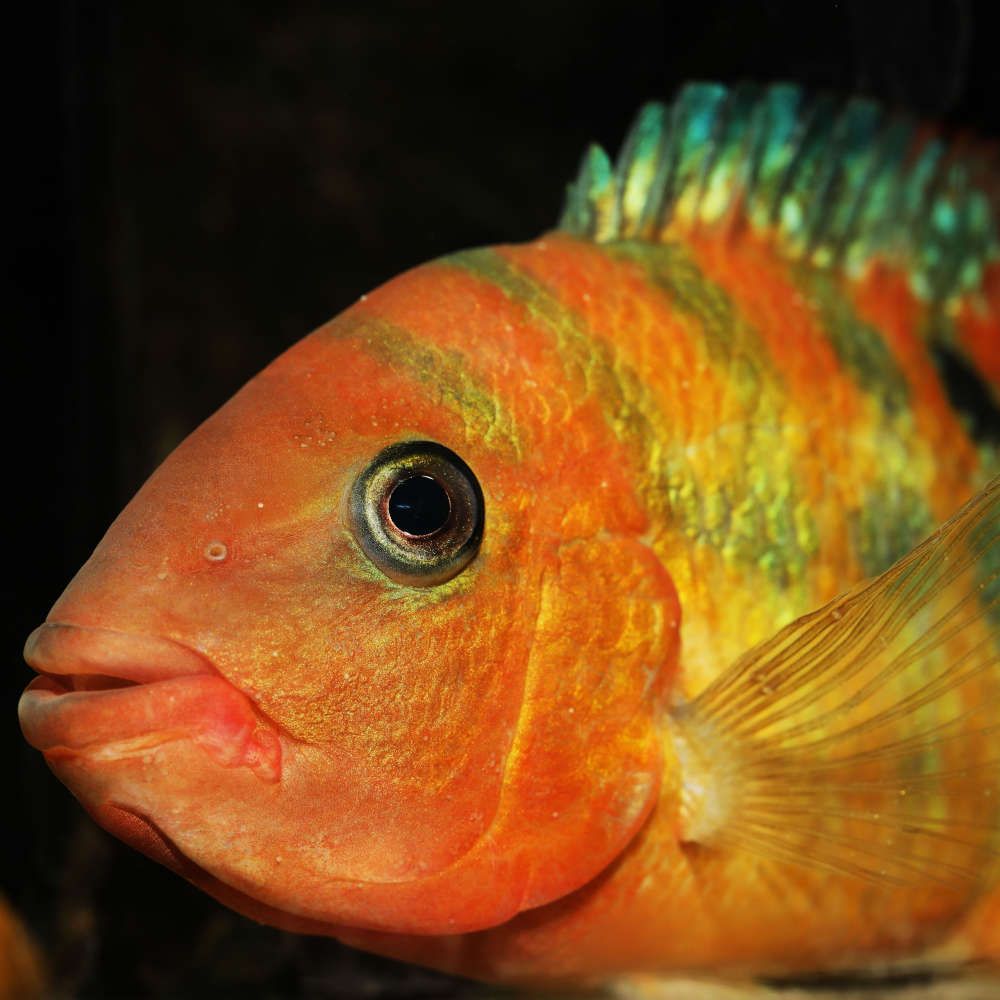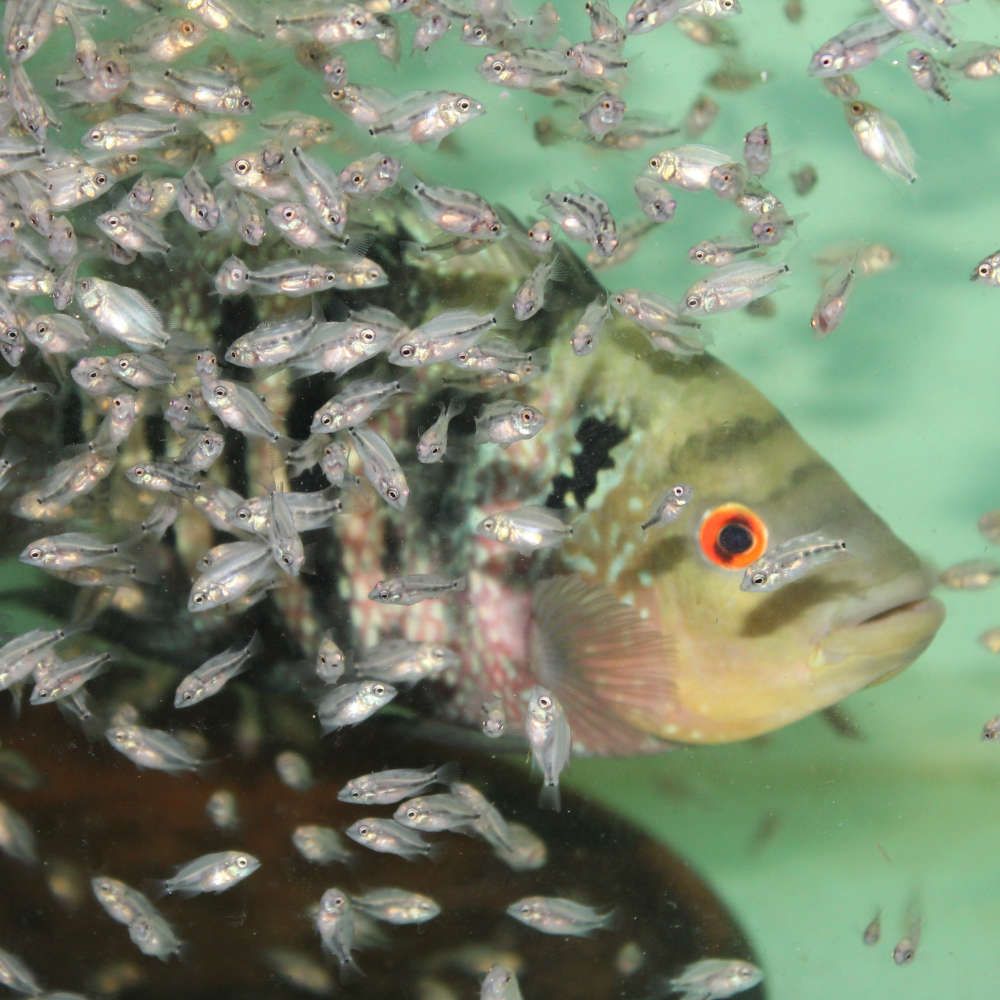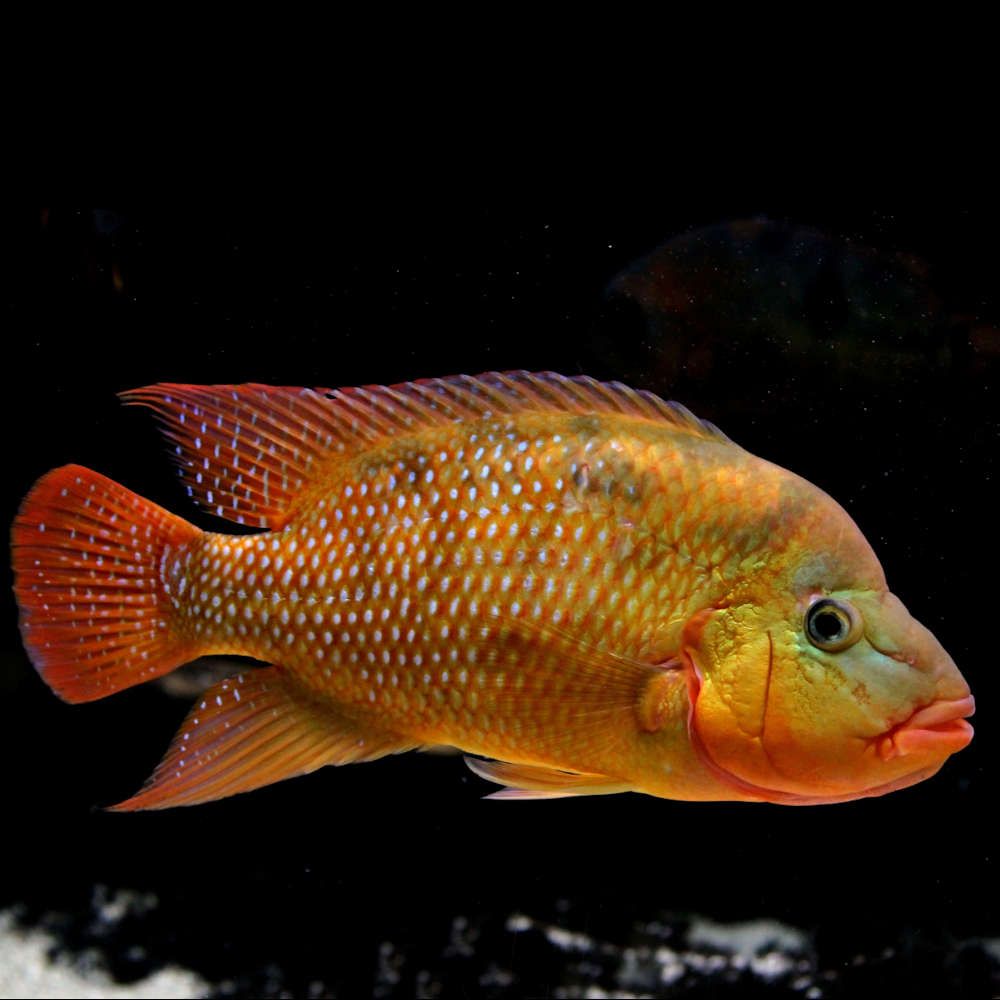If you are looking for a large and fierce fish for a spacious freshwater aquarium, look no further than red terror cichlids.
They will surely make your aquarium more vibrant with their unique personality. It’s great fun to nurture this species and pamper them with your care.
So, if you’re fascinated by this charming fish and want to bring it home, continue reading.
What is a Red Terror Cichlid?
| Origin | South America, Pacific drainages Esmeraldas River, Ecuador; Tumbes River, Peru. |
| Order | Perciformes |
| Family | Cichlidae |
| Scientific Name | Mesoheros festae |
| Common Names | Red terror cichlid, Festae, Festae cichlid, Guayas cichlid, Harlequin cichlid |
| IUCN Red List Status | Not Evaluated |
| Appearance | Red oval fish with prominent black stripes along the body |
| Size | In captivity, female fish: up to 33 cm (13 in), male fish: up to 45 cm (18 in) |
| Lifespan | Up to 10 to 15 years in captivity |
| Temperament | Aggressive and territorial behavior, especially during breeding periods. |
| Tank Level | Primarily a mid to bottom-dwelling fish |
| Water Temperature | 75-82 °F (24°C – 28°C) |
| pH Level | 6.5-7.5 |
| Water Hardness | 5-16 dGh |
| Care Level | Moderate – Intermediate Level |
| Minimum Tank Size | 180-225 gallons for a pair depending on the size |
| Tank Environment | Provide plenty of hiding spots and caves using rocks and plants |
| Diet | Primarily carnivorous, but accepts omnivorous feed |
| Tank Mates | Other big and aggressive fishes |
What is the Natural Habitat of Red Terror Cichlid?
Red terror cichlids are native to the Pacific drainages in South America, ranging from the Esmeraldas River in Ecuador to the Tumbes River in Peru. The fish has been observed as an invasive species in the waters of Singapore and Thailand.
They inhabit freshwater environments, typically found in warm tropical waters with temperatures ranging from 24 to 28°C.
In their natural habitat, these cichlids prefer rocky areas where they can hide and create territories. They are territorial and aggressive, especially during breeding periods, making rock formations essential for shelter and spawning sites.
What is the family of Red Terror Cichlid?
Red terror cichlids are a part of the Cichlidae family and belong to the order Perciformes. The binomial name of the species is Mesoheros festae.
They are known by multiple common names worldwide, like festae cichlid, guayas cichlid, harlequin cichlid, red terror cichlid, true red terror cichlid, and red terror fish.
Fun Fact: Red terror cichlids form lifelong mating pairs. They stay together with their mates throughout their lives.
How does Red Terror Cichlid Look?

Now, if you’re eager to learn more about its physical traits and behaviors, let’s delve right in!
What is the Size of Red Terror Cichlid?
In captivity, female fish generally attain a size of around 33 cm (13 inches), whereas males can grow up to 45 cm (18 inches) in length.
What is the Color of Red Terror Cichlid?
Red terror cichlids exhibit a striking red color body with prominent black stripes all along.
How is Red Terror Cichlid different from from a Mayan fish?
There’s a fish that’s often mistaken for red terror cichlids – called Mayan or false red terror cichlid. You can tell them apart by following details:
1. The red terror’s first two vertical bars (closest to the face) connect to form a Y-shape. These bars don’t connect in the false one.
2. The red terror’s false eye spot is on the upper portion of the back fin in an off-center position. In the false red terror, the eye spot is right at the center.
What are the Features of Red Terror Cichlid?
The fish has an oval, bilaterally symmetrical body. When seen from below, the dorsum and anal fins appear black against the sky.
How is a male and female Red Terror Cichlid different?
Females have a beautiful reddish-brown color with vertical black stripes and charming tiny blue spots on their bright red-orange snouts.
Males, on the other hand, feature a stunning turquoise-green body with tails adorned in vibrant orange and blue stripes.
Female fish are usually smaller in size than males.
How does Red Terror Cichlid behave in the tank?
Red terrors are highly territorial fish and display aggressiveness, creating an imposing presence in the aquarium. These cichlids are known for their expressive behavior.
Both males and females reach the peak of their aggression during their breeding time when spawning or protecting their fry. They fiercely defend their territories and establish hiding spots in the aquarium.
Their assertive behavior adds excitement to the aquarium environment. But it’s important to ensure enough space and hiding spots to reduce potential conflicts among tank mates.
What is the Lifespan of Red Terror Cichlid?
The species can live for about 10 to 15 years in captivity, provided they receive proper care and a suitable environment.
How to take care of Red Terror Cichlid?

If you’re eager to add this captivating fish to your aquarium, let’s explore essential care tips to ensure its well-being!
What is the Tank Size for Red Terror Cichlid?
These cichlids should be kept in pairs, forwhich a minimum of 180-225 gallons is recommended. The tank size depends on the size of your specimens.
In my experience, the 225-gallon tank is a safe bet as it provides a spacious environment to reduce stress and aggression.
If you want to build a community tank or add more of them, you must upgrade the tank size by at least 30 gallons to accommodate their territorial behavior.
What is the Water Chemistry for Red Terror Cichlid?
To keep your red terror healthy and ensure its longevity, make sure you maintain the following water parameters.
- pH Levels: 6.5-7.5
- Water Temperature: 75-82 °F (24°C – 28°C)
- Water Hardness: 5-16 dGh
- Ammonia: 0 ppm
- Nitrite: 0 ppm
- Nitrate: Below 30 ppm
What should be the Tank Environment for Red Terror Cichlid?
A well-designed aquarium environment is vital for your pet fish’s mood and overall health. So, let’s craft the ideal home for them!
Which type of Substrate is needed for Red Terror Cichlid?
Use a mixture of fine gravel or soft sand, as these fish love to dig and rearrange the substrate. This creates a natural setting and allows them to express their territorial behavior.
Which Plants are needed for Red Terror Cichlid?
Include hardy plants like Java fern, Anubias, or large Amazon swords, as they can tolerate the fish’s active nature.
Which Lighting is needed for Red Terror Cichlid?
Red terror cichlids generally prefer moderate lighting in their aquarium as they are used to swimming in the shady areas in their natural habitat.
Moderate lights will provide enough light for the growth of live plants without stressing the fish.
Avoid extremely bright light, as it may make the cichlids feel uneasy and lead to hiding or increased aggression.
What Décor is needed for Red Terror Cichlid?
Incorporate a variety of decor elements like rocks, driftwood, and caves. You need to create territories and hiding spots for the species.
These fish enjoy rearranging the environment to suit their preferences. Make sure you plan ample hiding places to reduce stress and aggressive behavior.
You must always check whether the decorations are securely placed to prevent injury to the fish.
Which Filtration system is needed for Red Terror Cichlid?
To ensure clean and healthy water conditions, prevent water pollution, and promote the fish’s well-being, a robust filtration system like a canister filter is vital. They are messy eaters and produce massive bio-waste.
What is the Water Flow Rate required for Red Terror Cichlid?
The water flow rate should be strong. They are adapted to river environments with strong currents. Aim for even water circulation throughout the tank.
Fish Care Tip: Perform a monthly full water change, accompanied by weekly partial changes. This will help you to maintain healthy waterquality for this fish.
What does Red Terror Cichlid eat?
It is a carnivore in its natural habitat. However, they also accept omnivorous feed in captivity.
You should provide them with a mix of live foods and pellets/flakes for proper growth. Make sure the dry foods are rich in protein content. For a balanced diet, feed them with :
- Small shrimps
- Fruits
- Seeds.
- Brine shrimp
- Daphnia
- Mealworms
- Earthworms
- Green peas
- Blanched spinach
- Lettuce
Some fish can become picky eaters. If you have a picky red terror cichlid, withhold live foods until they accept pellets and adjust to them. They can fast for a couple of weeks. It won’t harm their health.
What are the Tank Mates for Red Terror Cichlid?
Inexperienced aquarium enthusiasts should keep all red terrors alone in a dedicated tank.
Experienced aquarists can create a community tank with red terror cichlids and other large, robust fish, making the aquarium more diverse and exciting. They can be housed with the following species:
- Arowanas
- Sailfin plecos
- Oscars
- Flowerhorn cichlids
- Managuense cichlids
- Common plecos
- Green terrors
However, remember to provide plenty of space and a hiding area for the red terrors to claim their territory.
Which Tank Mates to Avoid for Red Terror Cichlid?
Red terror cichlids are aggressive. They tend to eat any fish or tank mate that fits in their mouth. Therefore avoid the following:
- Peaceful species: They will be harassed by the aggressive cichlid.
- Slow species: They won’t be able to escape if the cichlid attacks or chases them.
- Weaker species: They might not defend themselves well against the aggressive cichlid.
- Smaller species: Red terrors will prey on them.
- Shy and timid species: Red terrors are active species, which might cause stress to shy species housed together.
Also, avoid housing a single red terror (without a mate) with a breeding or pair of red terror cichlids because this can cause fights and aggression.
What are the Common Diseases in Red Terror Cichlid?
Red terror cichlids usually stay healthy so long as proper care measures are undertaken. Yet, sometimes they fall prey to certain common diseases. So, stay prepared to diagnose and treat the following.
| Disease Name | Causes | Symptoms | Treatment |
|---|---|---|---|
| Ich | Protozoan Parasite Infection | Flashing, lethargy, white spotting, appetite loss | Increasing aquarium temperature, addition of ich medicines or aquarium salts. |
| Columnaris | Bacterial Infection | White or gray patches, lethargy, fraying of fins, appetite loss | Antibiotics, water quality improvement, stress reduction. |
| Hole in the head | Parasite infection | Loss of appetite, pitting-type lesions, trailing mucus | Separating the fish, adding antibiotics, improving nutrition, improving water quality |
| Fin Rot | Bacterial Infection | Appetite loss, Fin disintegration or fraying, lethargy, and fin discoloration | Adding antibiotics, improving water quality, remove any objects that could cause physical harm to them. |
Disease Prevention Tip: Regularly maintain water quality, provide a balanced diet, and quarantine new fish to prevent common diseases.
How to Breed Red Terror Cichlid in an aquarium?
Due to their aggressive nature, breeding red terrors is challenging. It’s essential to ensure the right conditions to encourage successful breeding.
Selecting a mated pair is preferable, as females can be picky about their mates.
What type of pair should you get for breeding Red Terror Cichlid?
An unbonded pair of red terrors can lead to the death of weaker fish. So, it’s better to get a small group of juvenile fish. You will get naturally bonded pairs from the group.
What are the Ideal Mating Conditions for Red Terror Cichlid?
Prepare a breeding tank of 180-225 gallons or relocate other tank mates to a different tank.
Maintain a water temperature between 78-82 °F to promote spawning. Keep a male-to-female ratio of 1:1 in the breeding tank. Feed them protein-rich food to stimulate the spawning process.
The species is a cave brooder, so make sure there are plenty of caves and toppled flower pots in the tank.
What are the Signs of Breeding in Red Terror Cichlid?
The male fish loses its vibrant colors when it reaches reproductive age, typically around three to four inches in length. This is a sign that he is ready to breed. Females also exhibit aggressive behavior while choosing a mate.
What is the Mating Ritual for Red Terror Cichlid?
Female fish engage in a mating ritual by interlocking their jaws to determine the male’s suitability. The female deposits up to 100-3000 big eggs in a nesting area, such as large rock caves, and the male fertilizes them.
When do Red Terror Cichlid eggs hatch?
Red terror eggs usually hatch after 96 to 120 hours. The parents create small holes in the substrate to observe and protect the fry until they are old enough to be independent, which usually takes up to two weeks to ensure their survival.
Most of the time, parental care and surveillance continue even after they become free swimmers.
Breeding Tip: Provide proper meals and maintain a stable environment during the breeding process to increase the chances of successful reproduction in captivity.
How to buy Red Terror Cichlid?
Buy a group of juvenile fish from the same store and tank to enhance the chances of peaceful coexistence within the group.
A word from FishInAquarium
A tank with red terror cichlids is extremely rewarding as they are colorful and expressive. Their activities are bound to keep you entertained for long hours. With proper research and care, you can create a harmonious aquarium at your home.
So, did you enjoy the article? If yes, feel free to share it with fellow fish enthusiasts. But if there are any queries, reach out through email, and we’ll solve things together!


